A Perfect Day Trip to Yoho National Park : The Jewel of the Rockies
Yoho National Park, situated in the heart of the Canadian Rockies, offers a memorable experience for all nature lovers and adventure seekers. Renowned for its magnificent mountain views, crystal-blue lakes, and majestic waterfalls, Yoho is a great choice for a day trip destination that will enthrall you with the sheer beauty of Canadian nature.
Yoho is a park that lets you forget the stresses of modern urban life, whether you prefer hiking near the magnificent Emerald Lake, admiring the breathtaking Takakkaw Falls, or simply soaking in the park’s peaceful atmosphere. In this guide, we shall cover the best things to see to make the best of your day trip to Yoho National Park and guarantee you a picturesque and memorable adventure in one of the most beautiful parks in Canada.
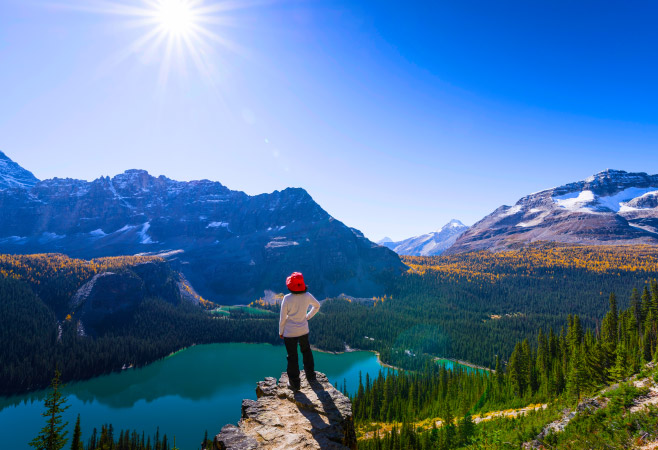
This makes it ideal for outdoor adventurers who want to experience peace, tranquility, and exquisite natural beauty.
- Where is Yoho National Park located in Canada?
- Best time to visit Yoho National Park
- Yoho national park entry fees and opening hours
- Entrance fees
- How to get to Yoho National Park?
- Top Things to Do in Yoho National Park
- 1. Marvel at the Emerald Waters of Emerald Lake
- 2. Witness the Majestic Takakkaw Falls
- 3. Hike to Wapta Falls
- 4. Discover Natural Bridge
- 5. Visit Lake O’Hara (Advance Booking Required)
- 6. Explore Burgess Shale Fossil Beds
- 7. Stroll Through the Town of Field
- 8. Take the Iceline Trail for Unmatched Views
- 9. Go Camping Under the Stars
- Essential tips for traveling to Yoho National Park.
Where is Yoho National Park located in Canada?
Yoho National Park is located in the Canadian Rockies, within the province of British Columbia. It is along the Trans-Canada Highway (Highway 1), and the fact that it is near the town of Field in the Kootenay region makes it distinctive. The park, together with the rest of the Canadian Rocky Mountain Parks (a UNESCO World Heritage Site), incorporates other well-known parks such as Banff and Jasper.
There is easy access to Yoho National Park because it is adjacent to the other Banff National Park of Alberta. Yoho has dramatic topography and is famous for its high mountains, rich valleys, glaciers, and many waterfalls, with the famous tourist sites being Emerald Lake and Takakkaw Falls. Being located very close to the town of Golden, British Columbia, and other common outdoor destinations, it is one of the places that nature lovers and adventure seekers should visit.
Best time to visit Yoho National Park
The best time to visit Yoho National Park largely depends on the kind of experience you want to have. Here's a breakdown:
- Summer (June to August):
- Suitable for hiking, camping, and other outdoor activities. In these months the weather is optimum, being warm with temperatures varying between 15°C and 25°C (59°F and 77°F), which makes the weather highly convenient to visit the park's renowned hiking trails such as the Iceline Trail or Emerald Lake Loop.
- Most of the park facilities and accommodations are open, and the higher elevations are typically snow-free by mid-June.
- It is also a high season of tourism, and thus more people are expected, especially in such tourist attraction sites as Takakkaw Falls and Emerald Lake.
- Fall (September to October):
- Fall is an excellent time to view colorful foliage, as the park’s forests turn vibrant shades of red, orange, and yellow.
- It is not too cold yet; however, the crowds are decreasing, and people get a bit more quiet in comparison to summertime.
- Higher trails can be closed owing to early snowfalls; however, this is also a great period to carry out photography and a peaceful trip.
- Spring (April to May):
- A good way not to be hustled around with the crowds is to pack a pair of snowshoes. Weather may still be uncertain, the temperature may vary between 5°C and 15°C (41°F and 59°F), and certain routes can still not be explored because of snow and mud.
- You can stay ahead of the tourist crowds and have an early look at the beauty of Yoho early in the spring. However, be sure to check trail conditions and carry on with clothes that will help you stay warm.
- Winter (November to March):
- Perfect for winter sports enthusiasts. Winter transforms the park into a peaceful snowy wonderland in case you are a skier, snowshoer, or even a photographer. The park is much less congested, but it is possible that the temperature can reach -10°C (14°F) and even lower.
- There are snow-covered roads and trails that are not accessible, so it is always good to know in advance before visiting the park. The services in the park might not be available in the park.
Overall, late June to early September is the most popular time to visit, with summer being ideal for outdoor activities and enjoying the park's full range of attractions.
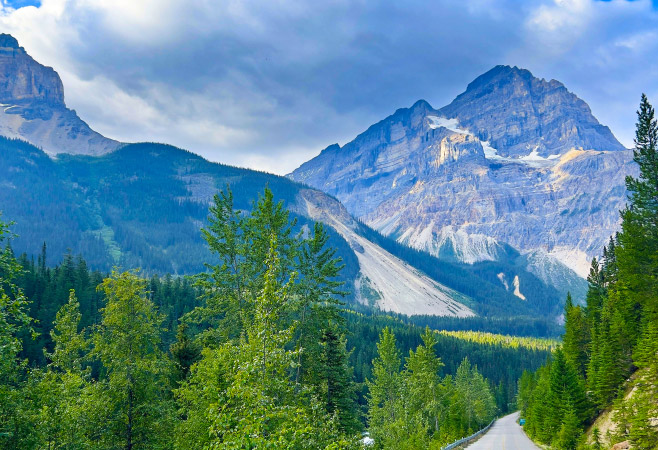
Yoho National Park offers unique experiences in each season
Yoho national park entry fees and opening hours
Entrance fees
|
Category |
Daily Fee (CAD) |
Validity Period |
| Adult (18–64 years) | $11.00 | 1 day |
| Senior (65+ years) | $9.50 | 1 day |
| Youth (6–17 years) | Free | 1 day |
| Family/Group | $22.00 | 1 day |
Note: Youth aged 17 and under receive free admission at all Parks Canada locations.
Additionally, Parks Canada offers the Discovery Pass, which provides unlimited admission to over 80 national parks and historic sites across Canada for one year:
|
Category |
Price (CAD) |
| Adult (18–64 years) | $75.25 |
| Senior (65+ years) | $64.50 |
| Family/Group | $151.25 |
Note: The Discovery Pass is valid for 12 months from the date of purchase and is ideal for visitors planning to explore multiple Parks Canada locations.
Youth under 17 are always free, and Parks Canada occasionally offers free days (e.g., Canada Day), but most visitors need a valid daily pass or Discovery Pass.
Please note that these fees are subject to change, and it's advisable to check the official Parks Canada website for the most current information before planning your visit.
Yoho National Park opening hours:
Yoho National Park is open year-round, with peak visitation occurring during July and August. However, some services are only available from May to early October. The Yoho National Park Visitor Centre offers information and exhibits to enhance your visit. Its operating hours are as follows:
|
Dates |
Hours |
| May 1 – June 5 | 9:00 AM – 5:00 PM |
| June 6 – September 22 | 9:00 AM – 6:00 PM |
| September 23 – October 13 | 9:00 AM – 5:00 PM |
| October 14 – April 30 | Closed |
The Visitor Centre has year-round, 24-hour public washrooms. The center also contains a gift store of Friends of Yoho National Park, where the visitors can buy a souvenir. For your information, there are areas in the park and service that may be closed or restricted during the season. To get up-to-date closures and restrictions, visit the Important Bulletins page on the Parks Canada website.
The official Yoho National Park website provides more information on seeing the park and what to do and where to stay.
How to get to Yoho National Park?
Yoho National Park is within the southeastern part of British Columbia in Canada and is situated alongside the band of western slopes of the Canadian Rockies. It is not even as famous as the communities around it—Banff and Jasper—though it provides scenic beauty, turquoise lakes, and waterfalls, and fewerpeople visit it, making it an ideal place to visit in the outdoors and drive up the mountains as you suit yourself to nature. Here’s how you can get there:
By Car (Most Convenient Option)
Driving is the most practical way to reach Yoho National Park.
- From Calgary: The drive to Yoho National Park is approximately 210 to 250 km west via the Trans-Canada Highway and takes about 2.5 to 3 hours. Driving through Banff and Lake Louise, you will then cross the border into British Columbia, where the park starts in the tiny town of Field.
- From Banff/Lake Louise: Yoho is a 30-minute drive west of Lake Louise. Stay on Highway 1, and you will come across the names of Emerald Lake, Takakkaw Falls, and more.
- From Vancouver: It is a much longer journey—approximately 800 km or 8–9 hours by road using Highway 1 east. A lot of drivers divide their driving days and spend a night in such destinations as Kamloops or Revelstoke.
Since there is no public transportation within the park, having your own vehicle offers the flexibility to explore Yoho’s many scenic sites at your own pace.
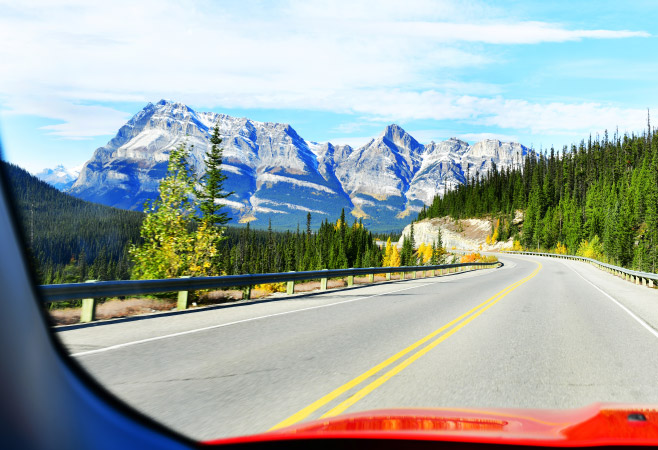
With Highway 1 (the Trans-Canada Highway) running through the center of Yoho, most people visit by car or RV.
By Air
The nearest major airport is Calgary International Airport (YYC) in Alberta. From there:
- Rent a car directly at the airport and drive west to Yoho National Park.
- Alternatively, book a bus or shuttle to Banff or Lake Louise, and rent a vehicle there to continue to Yoho.
By Bus or Shuttle
- Calgary, Banff, and Lake Louise are connected by buses launched by such companies as Brewster Express and Mountain Park Transportation.
- Nevertheless, there are no direct connections of the regular buses that run to Yoho National Park or its sights, Emerald Lake or Takakkaw Falls. You will have to drive or make advance reservations for tours in surrounding towns.
By Train
- While VIA Rail and Rocky Mountaineer trains pass through the region (notably the Kicking Horse Pass), they do not stop inside the park.
- You could disembark in nearby Golden, BC, or Banff, then rent a car or arrange transport.
Lake O’Hara Access
When going to Lake O'Hara, a shuttle bus that is run by Parks Canada has to be booked months before you visit Lake O'Hara. Hiking to the lake is allowed (11 km one way), but there is no access to a private vehicle.
Top Things to Do in Yoho National Park
Yoho National Park is a hidden treasure that usually astonishes its viewers by its overwhelming beauty and peaceful serenity. Yoho is situated in British Columbia, directly to the west of the Banff National Park, so it is an unforgettable experience for adventurers, nature lovers, and road trippers as well. No matter the type of weekend getaway you have in mind or a day trip in the Yoho National Park, you will have a chance to enjoy a great variety of amazing sceneries and activities.
The following are the top things to do in Yoho National Park to have a memorable experience.
1. Marvel at the Emerald Waters of Emerald Lake
Most likely, the most recognizable location in the park is Emerald Lake. Its clear blue waters with snowcaps as the surroundings are ideal to canoe, trek, or admire the view as you sit in the lakeside lodge. It has a flat 5.2 km loop trail that circles around the lake and is easy and scenic with something of interest to people of all fitness levels. Go in the first half of the day or the late afternoon when there are not too many people and the light is less intense.
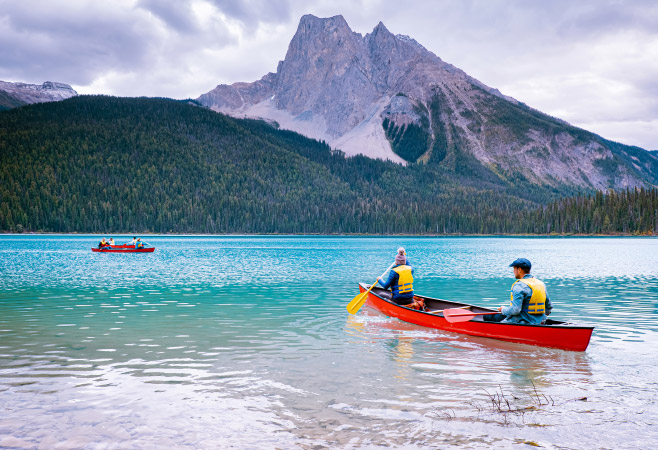
Emerald Lake is a fantastic place to see wildlife, as animals are drawn to the important water source.
2. Witness the Majestic Takakkaw Falls
Takakkaw Falls has a total height of 373 m, with the main free-fall drop measuring 254 m, making it one of the highest waterfalls in Canada. The base is only a short drive from the main highway and a short walk away as well, as is the parking lot. As you approach, you can even feel the refreshing mist on your face—an unforgettable part of the experience. This beautiful waterfall is stunning, especially during summer when the melting of snow in Daly Glacier feeds its flow.
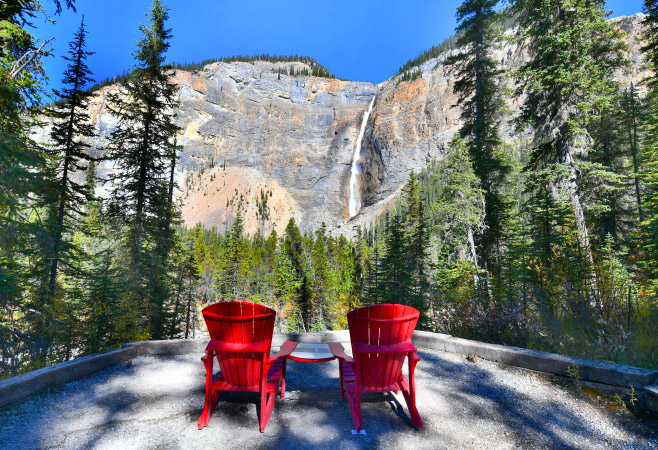
It's among the highest waterfalls in all of Canada and easily one of the most dramatic.
3. Hike to Wapta Falls
Wapta Falls, less popular but equally breathtaking, is a great destination to hike through the wooded landscape to a broad curtain of falling water on the Kicking Horse River. The moderate-difficulty round-trip trail is 4.8 km and provides you with both a viewing point above as well as below the falls. It is a serene site to have a picnic or some tranquil thoughts.
4. Discover Natural Bridge
The Natural Bridge is a mysterious rock formation in which the water of the Kicking Horse River has created a tunnel in the solid rock. Easily reachable by car and only a few minutes’ drive from Field, this location is a demonstration of the raw strength of nature as well as a point of multiple viewpoints, photographic and observational-wise.
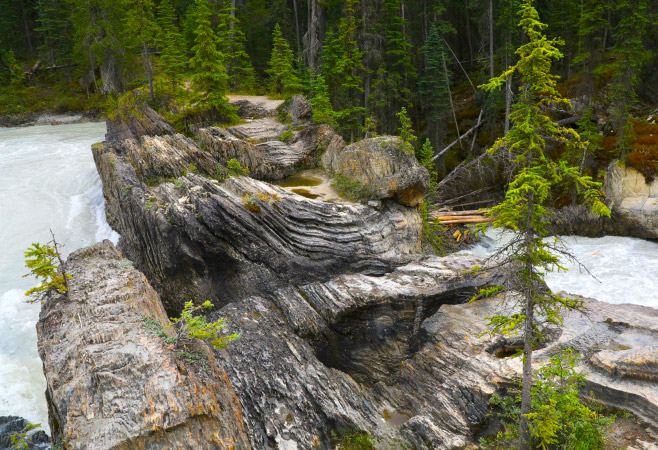
Natural Bridge is an impressive natural rock formation that spans the flow of the Kicking Horse River west of Field.
5. Visit Lake O’Hara (Advance Booking Required)
For those seeking a more remote, pristine wilderness experience, Lake O’Hara is unparalleled. Access is limited to protect the sensitive alpine environment, and visitors must book a shuttle months in advance through Parks Canada. Once there, you’ll find stunning hikes like the Opabin Plateau and Lake Oesa trails, with breathtaking vistas at every turn.
6. Explore Burgess Shale Fossil Beds
To the lovers of history and science, the Burgess Shale Fossil Beds give an incredible view of the ancient marine life more than 500 years old. This site can only be visited as a guided tour, and it is a UNESCO World Heritage Site and an interesting place to visit, in case you have interest in paleontology and geology.
7. Stroll Through the Town of Field
This is a small village that acts as the center of Yoho National Park. The field has quaint lodging, a visitor center, and snug cafes and is an ideal station to expound on adjacent trails and waterfalls. Inquire and get to know more about the geology of the park, the wildlife, and the Indigenous history of the park.
8. Take the Iceline Trail for Unmatched Views
One of the best things to do in Yoho National Park for experienced hikers is the Iceline Trail. This high-elevation trail offers panoramic views of glaciers, alpine meadows, and valleys far below. The full loop is 20+ km, but even a shorter out-and-back hike rewards you with incredible scenery.

One of the premier hikes in Yoho National Park features grand views of glacier-clad peaks, rugged alpine landscapes, and dramatic waterfalls.
9. Go Camping Under the Stars
Yoho is home to several campgrounds like Kicking Horse and Monarch, which allow visitors to immerse themselves in the natural beauty of the park. On a clear night, the starry skies and mountain silhouettes create an unforgettable outdoor experience.
Essential tips for traveling to Yoho National Park.
What to Pack
- Layered Clothing: Mountain temperatures are extremely changeable. Layer appropriately so that you may add or drop layers according to changes in temperatures, sun, wind, or rain conditions.
- Sturdy Footwear: ease in walking even in short hikes since the route may be steep or rough; it is also very important to have well-worn, sturdy hiking shoes or boots.
- Rain Gear: The rain is common, and a set of rainproof pants and a jacket would work excellently.
- Sun Protection: The rays of the sun are stronger at higher altitudes, so bring sunglasses, a hat, and sunscreen.
- Water and Snacks: Carry enough water and snacks that are energy boosters. The eating choices available inside the park are minimal, with the details of Emerald Lake Lodge and some more in the town of Field. Being self-sufficient is always preferable.
- Navigation: The most used trails are well-marked, but a map, compass (with knowledge of how to use it), or a good quality GPS tool is advisable (in particular on long hikes).
- First-Aid Kit: It would always be good to carry a small first-aid kit that can take care of minor cuts, blisters, and pain.
- Bear Spray: Yoho is bear country. Bring bear spray and be aware of its usage. Keep it in a place that is readily available other than in your pack.
Plan Your Visit
- Peak Season: The most visited time in Yoho is between July and September. In these months, the weather is mild, the majority of the most trails are snow-free, and all park buildings and roads are open (including Yoho Valley Road to Takakkaw Falls). You can witness waterfall flows in early spring (late May/early June) and a beautiful larch season with fewer crowds in fall (late September/early October).
- Check Road Condition: The weather in the mountains is unpredictable. Road conditions should always be checked in advance before your day trip to Yoho National Park, particularly not in peak summer. The Yoho Valley Road is usually closed between October and mid-June.
- Visitor Centre: Stop by the Yoho National Park Visitor Centre in Field for up-to-date information on trail conditions, weather forecasts, wildlife sightings, and any closures or advisories.
Park Passes and Fees
- Parks Canada Pass: You will need a valid Parks Canada Pass to enter Yoho National Park, just like other national parks in Canada. A daily pass, as well as an annual Discovery Pass (including admission to all the Canadian national parks and national historic sites), can be purchased online, at the park gates, or at visitor centers.
- Youth Admission: Children and youth under the age of 17 can be admitted into the park free of charge. Other charges, such as camping or certain guided programs, are, nevertheless, present.
Getting Around
- Personal Vehicle is Best: The Trans-Canada Highway (Highway 1) runs right through Yoho National Park, making it easily accessible by car or RV. Most of the main attractions have dedicated parking areas.
- No Public Transportation: There is no public transportation system within Yoho National Park, so having your own vehicle or joining a guided tour is essential.
- Parking: Parking lots at popular sites like Takakkaw Falls and Emerald Lake can fill up quickly during peak season. Arrive early or visit later in the afternoon to secure a spot.
Wildlife Safety
- Keep Your Distance: Remember to keep your distance from wildlife. Parks Canada advises that one should stay at least 30 meters (3 bus lengths) clear of elk and deer and 100 meters (10 bus lengths) clear of bears, cougars, and other big predators.
- Never Feed Wildlife: By feeding animals, their natural behavior can be changed, they become dependent on humans, and the risk of dangerous encounters for both people and animals increases.
- Make Noise on Trails: In bear country, it’s important to make noise while hiking to avoid surprising wildlife.
- Store Food Properly: When camping or picnicking, never put food and scented products out in a bear-resistant container, and never leave them unattended in your vehicle.
A day trip to Yoho National Park is the perfect way to experience the raw beauty of the Canadian Rockies without venturing too far off the beaten path. From the emerald waters of its namesake lake to the thunderous power of Takakkaw Falls and the quiet charm of Natural Bridge, Yoho offers an unforgettable escape into nature—all within a single day. Whether you're coming from Banff, Lake Louise, or Golden, this compact yet breathtaking park proves that even a short visit can leave a lasting impression.
International visitors from visa-exempt countries must apply for an eTA before flying to Canada. Travelers from visa-required countries need a visitor visa instead. With your ETA ready and your itinerary planned, Yoho is waiting to welcome you with breathtaking scenery and unforgettable adventures.
Related Articles
- Beyond the Grotto: An Insider's Travel Guide to Bruce Peninsula National Park
- Waterton Lakes National Park Travel Guide: Adventure Awaits in the Crown of the Continent
- From the Cabot Trail to Ceilidhs: The Ultimate Cape Breton Island Travel Guide for your dream vaction
- The Pinnacle of Comfort: Discovering the 15 Best Hotels in Québec City
- From Aurora Views to Old Town Trails: The 15 Best Places to Visit in Yellowknife You Can't Miss
- From Casual to Classy: 12 of the Best Restaurants that Winnipeg Has to Offer
- From Lakes to Glaciers : A Jasper National Park Travel Guide for the Adventurous Soul
- History, Nature, and Art: Your Essential Guide to the Top 12 Places to Visit in Sherbrooke
- Explore the Heart of the Fraser Valley: A Complete Guide to the Best Places To Visit in Abbotsford
- Essential Guide to Visiting Maligne Lake in Canada : From Spirit Island to Bald Hills
HOW CAN WE HELP?
APPLY WITH CONFIDENCE
|










